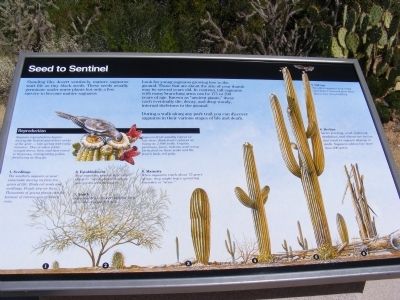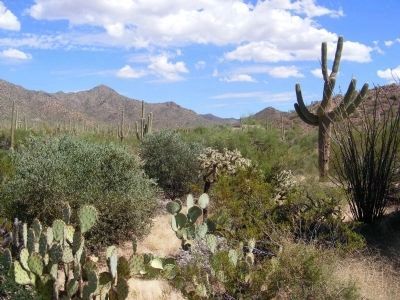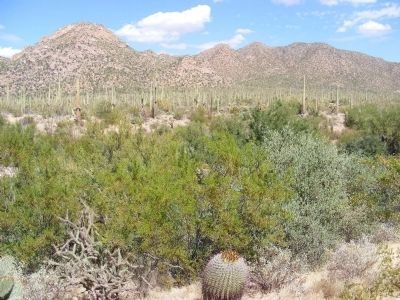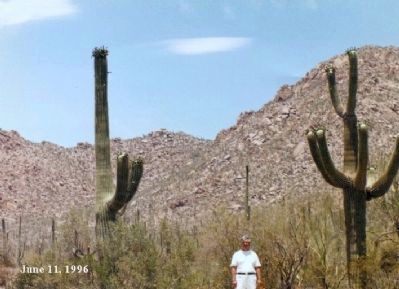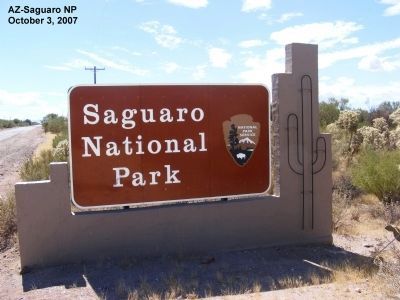Saguaro National Park in Tucson in Pima County, Arizona — The American Mountains (Southwest)
Seed to Sentinel
Saguaro National Park
Look for young saguaros growing low to the ground. Those that are about the size of your thumb may be several years old. In contrast, tall saguaros with many branching arms can be 175 or 200 years of age. Known as “ancient giants,” these cacti eventually die, decay, and drop woody, internal skeletons to the ground.
During a walk along any park trail you can discover saguaros in their various stages of life and death.
Reproduction
Saguaro reproduction begins during the hottest and driest weeks of the year—late spring and early summer. This is when white-winged doves, bees, and bats travel to blossoms, transporting pollen, fertilizing as they go. Saguaro fruit usually ripens in late June. Each fruit contains as many as 2,000 seeds. Coyotes, javelinas, foxes, rodents, and many birds feed on these seeds and the fruit’s lush, red pulp.
(Key to numbers)
1. Seedlings-The newborn saguaro is most vulnerable during the first few years of life. Birds eat seeds and seedlings. People step on them. Thousands of young plants can die because of intense sun or heavy rain.
2. Establishment-New saguaros survive best under shade or “nurse plants” such as palo verdes and mesquites.
3. Youth-Saguaros begin flowering after they grow about eight feet tall.
4. Maturity-When saguaros reach about 75 years of age, they might begin sprouting branches or “arms.”
5. Old Age-The oldest saguaros may weigh more than 7 tons and grow taller than a four-story building.
6. Decline-Severe freezing, wind, lighting, vandalism, and disease are factors that result in saguaro damage or death. Saguaros seldom live more than 200 years.
Erected by National Park Service, U.S. Department of the Interior.
Topics. This historical marker is listed in this topic list: Environment.
Location. 32° 15.246′ N, 111° 11.892′ W. Marker is in Tucson, Arizona, in Pima County. It is in Saguaro National Park. Marker is on N. Kinney Road. The marker is located at the visitor center garden in the Tucson Monument District. The garden is located on the left side of the visitor center between the parking lot and wash. Touch for map. Marker is at or near this postal address: 2700 North Kinney Road, Tucson AZ 85743, United States of America. Touch for directions.
Other nearby markers. At least 7 other markers are within 16 miles of this marker, measured as the crow flies. World of the Wash (within shouting distance of this marker); Desert Life (within shouting distance of this marker); The Tucson Plant Materials Center (approx. 11.4 miles away); Desert Laboratory (approx. 11.6 miles away); Mission San Xavier del Bac (approx. 15.1 miles away); a different marker also named Mission San Xavier del Bac (approx. 15.1 miles away); The Grotto at San Xavier del Bac (approx. 15.2 miles away).
Credits. This page was last revised on December 2, 2023. It was originally submitted on May 11, 2015, by Don Morfe of Baltimore, Maryland. This page has been viewed 378 times since then and 10 times this year. Photos: 1, 2, 3, 4, 5. submitted on May 11, 2015, by Don Morfe of Baltimore, Maryland. • Bill Pfingsten was the editor who published this page.
